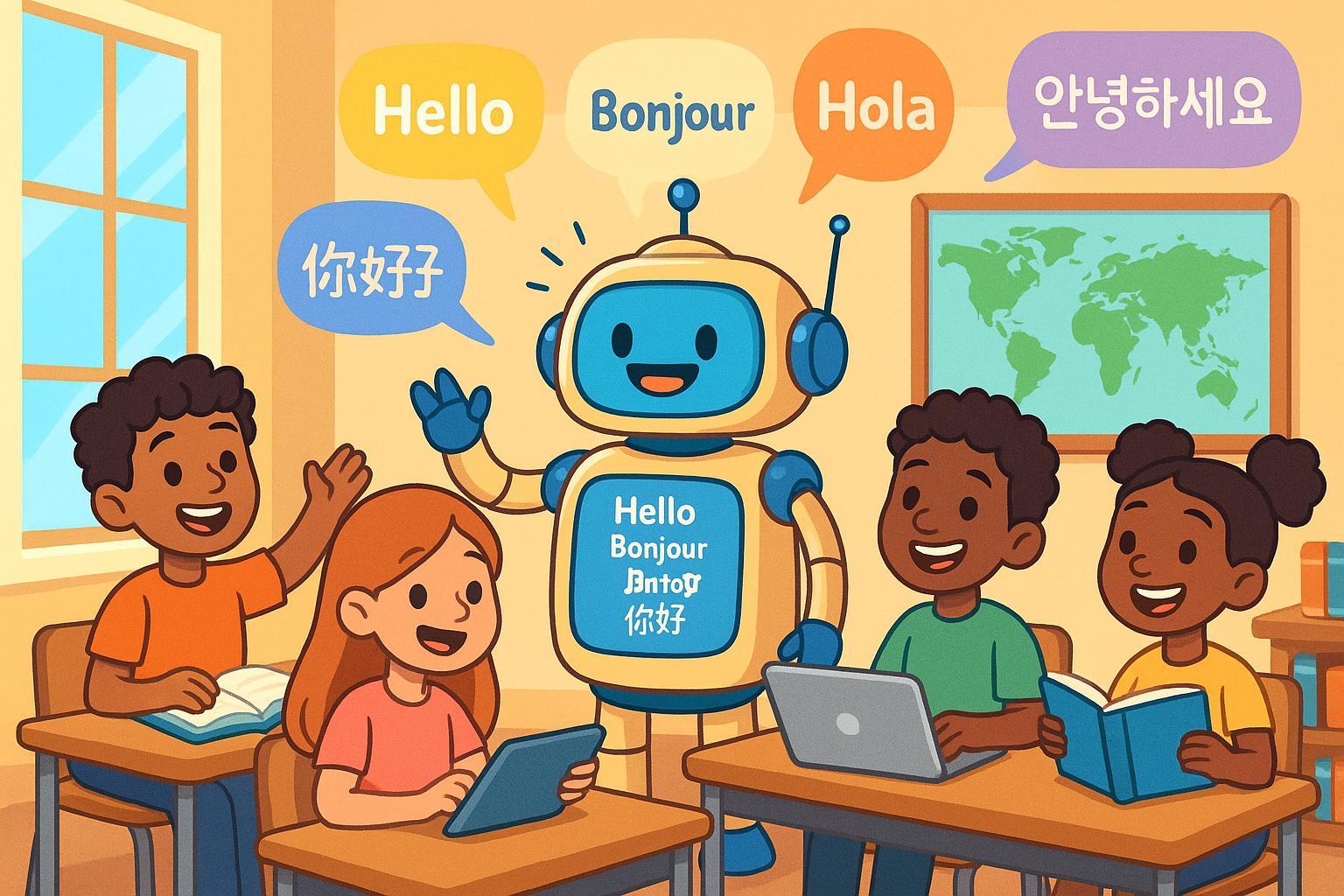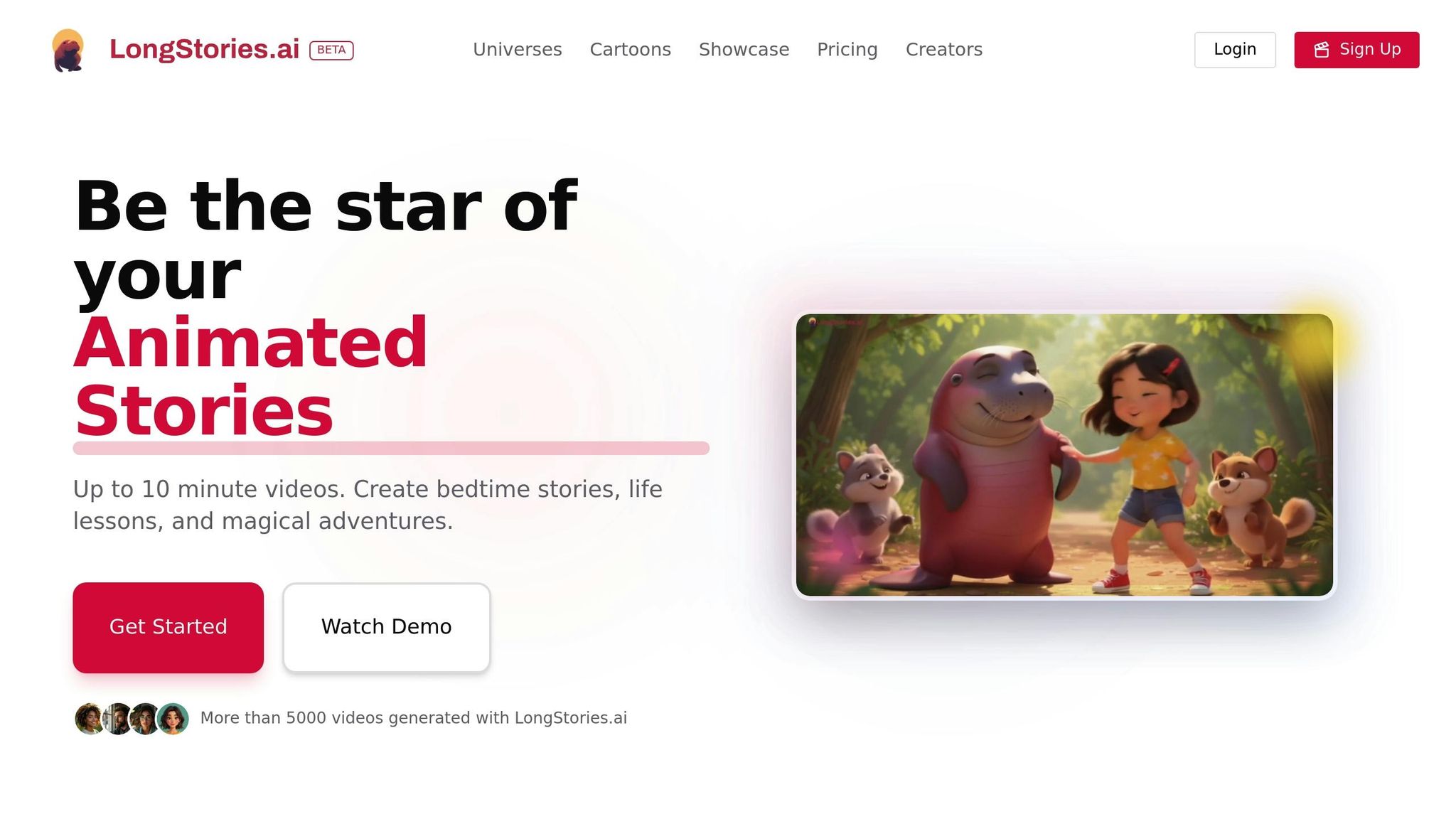
LongStories is constantly evolving as it finds its product-market fit. Features, pricing, and offerings are continuously being refined and updated. The information in this blog post reflects our understanding at the time of writing. Please always check LongStories.ai for the latest information about our products, features, and pricing, or contact us directly for the most current details.
Multilingual AI in Education: Benefits and Limitations
Multilingual AI tools are transforming education by helping schools support diverse learners. With 5.3 million multilingual students in U.S. classrooms, AI is addressing language barriers and enabling personalized learning experiences. Tools like real-time translation and adaptive learning systems allow students to access lessons in their preferred language while improving communication with families. However, challenges like translation accuracy, cultural nuances, and resource allocation remain significant hurdles.
Key Takeaways:
- Accessibility: AI tools provide real-time translations and text-to-speech features, helping students engage with lessons.
- Accuracy Issues: Many tools struggle with idiomatic expressions and regional dialects, especially for Spanish-speaking students.
- Personalization: AI platforms, such as LongStories.ai, create tailored, engaging content for individual learners.
- Challenges: Schools face difficulties in training, infrastructure, and addressing biases in AI systems.
Quick Comparison:
| Feature | General AI Tools | LongStories.ai |
|---|---|---|
| Accessibility | Broad language coverage | Developing multilingual features |
| Language Accuracy | 94% for many languages | Creates original narratives, avoiding errors |
| Personalization | Limited | High, with child-focused storytelling |
| Implementation Difficulty | Medium (established systems) | High (still in beta phase) |
Teaching Multilingual Learners with Generative AI: Affordances, Limitations, and Policy Implications
1. General Multilingual AI Tools
Multilingual AI systems are reshaping how schools support diverse student populations, offering new ways to address language barriers. However, their effectiveness varies across different educational areas, making it important for educators to weigh their strengths and limitations before adopting them.
Accessibility
One of the standout features of multilingual AI tools is their ability to break down language barriers, enabling students to engage more fully in their education. With real-time translation, students can access lessons, textbooks, and communicate with teachers in their preferred language. These tools can also translate educational materials, instructions, and assessments, often providing feedback in a student’s native language. Additionally, features like text-to-speech and speech-to-text ensure that multilingual learners, as well as students with visual or hearing impairments, can interact with educational content. Considering that over 43% of the world's population is bilingual and 17% is multilingual, these tools play a crucial role in making academic concepts more accessible.
However, while these tools improve accessibility, their language accuracy can sometimes be a stumbling block.
Language Accuracy
Despite their potential, multilingual AI tools often struggle with accuracy, which can impact their educational value. For example, Google Translate achieves an accuracy rate of approximately 94% for many languages. While impressive, this still leaves room for errors, especially in situations where precision is critical.
These challenges become more evident when translations involve cultural nuances. AI tools often oversimplify translations, missing the mark on idiomatic expressions, regional variations, or subtle cultural meanings. This is particularly concerning for U.S. public schools, where over 75% of emergent bilingual students are Spanish speakers. Additionally, linguistic biases can arise when AI systems are trained primarily on "standard" language varieties, resulting in poorer performance for speakers of other dialects and creating inequities in education.
Personalization
Modern multilingual AI tools are becoming better at tailoring learning experiences to individual students. In fact, the personalized learning market was valued at $1.8 billion in 2023. These tools can adapt content through features like adaptive learning paths, targeted vocabulary exercises, and grammar programs. They can even pinpoint specific phonemes that learners find challenging - often influenced by their native language - and design practice exercises accordingly. By offering visual, auditory, and interactive content, these systems cater to various learning styles. Multimodal learning, which combines text, audio, video, and interactive elements, is especially effective for the roughly 40% of students who show a preference for visual learning methods.
Implementation Challenges
While the benefits of multilingual AI tools are clear, integrating them into classrooms comes with its own set of challenges. One major issue is ensuring consistent educational standards across languages. Every language has unique grammar and syntax rules, and poor translations can lead to confusion and misunderstandings, negatively affecting learning outcomes.
Resource allocation is another hurdle. Although 57% of students report greater satisfaction when technology is used in learning, schools need to invest heavily in training, infrastructure, and ongoing support to maximize these tools' potential. Additionally, the digital language divide remains a concern. AI tools often struggle to accurately capture the language registers of diverse speakers, which can widen existing educational gaps.
Some tools can simplify complex texts, highlight key points, and improve content accessibility. However, successful implementation requires using AI as a supplementary tool - balancing its use with real-world language practice, peer collaboration, and direct interaction with educators. This approach ensures that technology enhances, rather than replaces, the human elements of learning.
2. LongStories.ai

LongStories.ai takes a creative leap in multilingual educational technology by turning a simple text prompt into a personalized animated story where the child becomes the star. Since its debut, the platform has created over 5,000 video adventures, showcasing its growing role in educational storytelling. By leveraging AI-powered narratives, LongStories.ai tackles some of the toughest challenges in multilingual education.
Accessibility
LongStories.ai redefines accessibility in educational content by offering personalized learning experiences across various languages. In under a minute, the platform transforms a single text prompt into an animated cartoon, cutting down the costs and time typically associated with animation production.
By placing each child at the center of their own story, the platform boosts engagement and emotional connection to learning materials. This is especially impactful for multilingual families, where generic educational content often fails to reflect a child’s identity or resonate with their experiences.
"Educators leverage AI's multilingual support to bridge language barriers, enabling international collaborations and inclusive learning environments".
The platform features AI Tellers like Manny the Manatee, Carter the Job Reporter, and Professor Time, each focusing on specific subjects while adapting to diverse languages. This aligns with the growing optimism in the tech industry, where 66% of leaders believe large-language-model AI will positively influence their companies' performance. Through accessible storytelling, LongStories.ai aims to break down language and cultural barriers in education.
Language Accuracy
LongStories.ai stands out in creating multilingual, child-friendly content. Its AI generates original educational narratives instead of relying on direct translations, reducing common pitfalls seen in other tools. This approach ensures narrative consistency across languages while maintaining the educational value of the stories.
Rather than translating word-for-word, the platform adapts stories creatively, addressing idiomatic and cultural nuances. This method allows the storytelling to resonate across different cultures without losing its purpose or meaning. By generating content from scratch, LongStories.ai ensures that children receive engaging, coherent narratives regardless of the language.
Personalization
Personalization is where LongStories.ai truly shines. The platform tailors stories to a child’s interests and learning style, creating a more engaging and effective educational experience. Its AI Tellers adapt content dynamically, moving away from the limitations of one-size-fits-all education.
The platform’s simplicity - requiring just one prompt - makes it accessible for parents and educators, even those unfamiliar with complex tools. Feedback from users highlights that personalized animated storytelling significantly boosts engagement and learning outcomes.
Implementation Challenges
Despite its achievements, LongStories.ai faces several challenges typical of multilingual AI systems. Data collection and preprocessing across multiple languages demand substantial resources, and ensuring accuracy across diverse linguistic contexts remains a constant hurdle.
Currently in its beta phase, the platform uses a waitlist system and gathers community feedback via Discord. This controlled rollout allows LongStories.ai to refine its features based on real-world input, ensuring its multilingual capabilities meet the needs of educators and families.
Another challenge lies in resource allocation - balancing the development of multilingual features while maintaining quality across all supported languages. The beta phase provides an opportunity to address these issues before scaling further.
The platform also confronts the digital language divide, striving to represent diverse linguistic communities accurately. As Nelson Mandela once said, "If you talk to a man in a language he understands, that goes to his head. If you talk to him in his language, that goes to his heart". This philosophy underpins LongStories.ai’s mission to create meaningful, culturally relevant content that resonates with children worldwide.
While these challenges are significant, they highlight the platform’s dedication to delivering high-quality, culturally sensitive educational material. By focusing on storytelling rather than direct translation, LongStories.ai is well-positioned to address the unique needs of multilingual education while maintaining the safety and quality standards essential for children’s content.
sbb-itb-94859ad
Pros and Cons
When considering multilingual AI in education, each approach offers its own set of strengths and challenges, requiring thoughtful evaluation to make informed decisions.
General Multilingual AI Tools
General AI tools are known for their broad language coverage and reliable performance. With an impressive 94% accuracy across numerous languages, these tools provide quick access to a wide range of educational materials, benefiting millions of multilingual learners. However, they often fall short in capturing the subtleties of cultural nuances, idioms, and regional differences. This "one-size-fits-all" approach may overlook specific learning needs that human educators are better equipped to identify.
There are also practical hurdles. Deployment can be complicated by algorithmic bias, high costs, and privacy concerns. These challenges highlight the need for more tailored solutions, such as the approach offered by LongStories.ai.
LongStories.ai's Approach
LongStories.ai takes a different route by focusing on personalized storytelling. Instead of merely translating existing content, it creates original narratives that align with cultural contexts across languages. Since its launch, the platform has produced over 5,000 video-based adventures, actively involving students as key participants in their learning experiences.
This student-focused design has shown measurable success. Personalized AI learning through LongStories.ai has been shown to improve language proficiency by 48.53% compared to traditional methods. However, as a platform still in its beta phase, it faces challenges like managing resources and ensuring quality across multiple languages. To address these, LongStories.ai uses a waitlist system for a controlled rollout while continuing to refine its features.
| Approach | Accessibility | Language Accuracy | Personalization | Implementation Difficulty |
|---|---|---|---|---|
| General AI Tools | High (broad coverage) | Good (94% accuracy) | Low (generic content) | Medium (established systems) |
| LongStories.ai | Medium (developing coverage) | High (original content) | Very High (child-centric) | High (beta refinement) |
Key Considerations for Educators
For educators - 55% of whom work with at least one multilingual learner in their classrooms - these factors are critical. AI platforms that provide real-time feedback on writing assignments, for example, can improve student writing skills by 71%, showcasing the potential educational benefits when implemented thoughtfully.
"AI is not a replacement for educators but a powerful ally in the pursuit of education excellence." – National Education Association
This comparison highlights the importance of balancing broad accessibility with tailored personalization. Success lies in using AI as a supportive tool rather than a substitute for human interaction. Schools must prioritize investments in robust technology infrastructure and adaptable AI platforms that can meet evolving needs. Regular feedback from both students and teachers is essential to ensure ongoing improvements. Whether choosing immediate widespread language support or focusing on long-term personalized engagement, the decision depends on institutional goals, with careful attention to privacy, bias, and fostering meaningful educational relationships.
Conclusion
Multilingual AI tools are reshaping education by making it more inclusive and tailored to the needs of diverse learners. With 40% of students worldwide not being taught in their native language, these technologies serve as a vital step toward leveling the educational playing field. Research shows that AI-powered personalized learning delivers better results compared to traditional methods, while AI-driven feedback systems help improve student performance across various areas.
That said, the key to success lies in responsible implementation. Schools must focus on transparency, maintain active human oversight, and commit to ongoing refinement when integrating these tools. This ensures AI complements teachers rather than replacing them, keeping the human connection at the heart of education. These steps align with the innovative applications we've explored earlier and help ensure ethical and effective use.
While general AI tools provide broad language support, platforms like LongStories.ai show how personalized approaches can foster deeper engagement by creating content that resonates with specific cultural contexts. This balance between accessibility and cultural relevance is crucial for meaningful learning experiences.
What can schools do next? They should start by conducting regular bias assessments, setting clear ethical standards, and investing in reliable technology infrastructure to ensure equal access for all students, regardless of socioeconomic background. Beginning with small-scale implementations, tracking measurable outcomes, and maintaining open communication with students, parents, and educators will help refine these efforts.
Beyond the classroom, the benefits of multilingual AI extend to economic opportunities. Studies show that bilingual individuals earn 5% to 20% more than monolinguals, and countries like Switzerland credit 10% of their GDP to their multilingual heritage. Tools like LongStories.ai highlight how culturally adapted storytelling can support both educational and economic progress. By embracing these technologies now, schools can prepare students for a future where multilingual skills open doors to academic and financial success.
As we break down language barriers in education, it’s essential to balance technological innovation with a commitment to human connection. This approach ensures that learning remains a transformative experience for every student.
FAQs
How can multilingual AI tools make education more accessible for students from diverse language backgrounds?
Multilingual AI tools break down language barriers, opening up educational opportunities for students worldwide. These tools provide features like real-time translation, personalized learning experiences, automatic subtitles, and support for multiple languages, making it easier for learners to access and engage with content in their preferred language.
By adapting content to various languages and cultural contexts, multilingual AI helps students grasp concepts more effectively and relate to the material on a deeper level. This approach promotes inclusivity and contributes to a learning environment where everyone has a fair chance to succeed.
What challenges do schools face when integrating multilingual AI into education?
Schools face a variety of hurdles when bringing multilingual AI into the classroom. One of the biggest roadblocks is the lack of reliable technological infrastructure - things like steady internet connections or suitable devices. Without these basics, implementing AI tools becomes a real challenge.
Another issue lies in ensuring accuracy and sensitivity in AI-generated content. Mistranslations or poorly adapted materials can create confusion and undermine lesson quality. There's also the concern of overreliance on AI, which might take away from the human connection and emotional support that are so crucial in education.
Teachers, too, face their own set of challenges. Balancing AI tools with keeping students engaged and addressing their diverse emotional and learning needs can be tricky. To tackle these obstacles, schools need to focus on proper training and thoughtful integration of AI into everyday teaching.
How does LongStories.ai create culturally relevant and accurate multilingual stories?
LongStories.ai leverages cutting-edge AI to craft stories that are not only linguistically precise but also mindful of cultural subtleties. Rather than sticking to simple translations, the platform adapts its storytelling to capture cultural nuances, adjusting the context and tone to suit the audience.
This thoughtful approach allows children and families from various backgrounds to enjoy stories that truly connect with their experiences and reflect their cultural identity, all while maintaining top-notch language accuracy.
